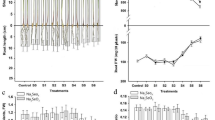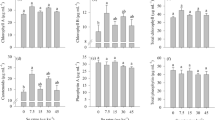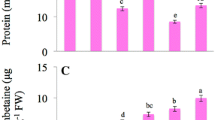Abstract
Bean (Phaseolus vulgaris L.) seedlings were subjected to varying selenium levels (1, 2, 4, and 6 ppm) in a hydroponic culture. The germination reached 100% in 48 h in all Se levels except 6 ppm, where it took 72 h. The root and shoot growth was stimulated at 1 and 2 ppm Se levels that was commensurate with increase in chlorophyll content, leaf water content, and cellular respiration. At 4 and 6 ppm Se levels, the growth was inhibited appreciably, which was associated with increase in stress injury measured as damage to membranes and decrease in cellular respiration, chlorophyll, and leaf water content. The oxidative injury as elevation of lipid peroxidation was larger compared to hydrogen peroxide accompanied by reduced levels of enzymatic (superoxide dismutase, catalase, ascorbate peroxidase, and glutathione reductase) and non-enzymatic (ascorbic acid and glutathione) antioxidants. Proline content was significantly higher at 1 and 2 ppm Se but diminished considerably at 4 and 6 ppm levels concomitant with the reduced growth. Exogenous application of proline (50 µM) resulted in substantiation of its endogenous levels that antagonised the toxic effects of Se by improving the growth of seedlings. The stress injury was reduced significantly with simultaneous increase in enzymatic and non-enzymatic antioxidants. Especially the components of ascorbate–glutathione cycle showed larger stimulation with proline application. The role of proline in mitigating the toxic effects of Se is discussed.



Similar content being viewed by others
References
Germ M, Stilbilj V, Kreft I (2007) Metabolic importance of selenium for plants. Eur J Plant Sci Biotechnol 1:91–97
Zhang L, Ackley AR, Pilon-Smits EAH (2007) Varaiation in selenium tolerance and accumulation among 19 Arabidopsis thaliana accessions. J Plant Physiol 164:327–336
Lyons GH, Genc Y, Soole K, Stangoulis JCR, Liu F, Graham RD (2009) Selenium increases seed production in Brassica. Plant Soil 318:73–80
Harrtikainen H, Xue T, Piironen V (2000) Selenium as an antioxidant and pro- oxidant in ryegrass. Plant Soil 225:193–200
Yokota A, Shigeoka S, Onishi T, Kitaoka S (1998) Selenium as inducer of glutathione peroxidase in low-CO2 grown Chlamydomonas reinharditii. Plant Physiol 86:649–651
Xue TL, Hartikainen H, Piironen V (2001) Antioxidative and growth-promoting effects of selenium on senescing lettuce. Plant Soil 237:55–61
Djanaguiraman M, Devi DD, Shanker AK, Sheeba JA, Bangarusamy U (2005) Selenium—an antioxidative protectant in soybean during senescence. Plant Soil 272:77–86
Shardendu Salhani N, Boulyga SF, Stengel E (2003) Phytoremediation of selenium by two helophyte species in subsurface flow constructed wetland. Chemosphere 50:967–973
Dhillon KS, Dhillon SK (2003) Distribution and management of seleniferous soils. Adv Agron 79:119–184
Padmaja K, Prasad DD, Prasad ARK (1989) Effect of selenium on chlorophyll biosynthesis in mung bean seedlings. Phytochem 28:3321–3324
Terry N, Zayed AM, deSouza MP, Tarun A (2000) Selenium in higher plants. Ann Rev Plant Physiol Mol Biol 51:401–432
Sharma SS, Dietz KJ (2006) The significance of amino acids and amino acid-derived molecules in plant responses and adaptation to heavy metal stress. J Exp Bot 57:711–726
Xu J, Yin H, Li X (2009) Protective effects of proline against cadmium toxicity in micropropagated hyperaccumulator, Solanum nigrum L. Plant Cell Rep 28:325–333
Kavi Kishore PB, Sangam S, Amrutha RN, Laxmi PS, Naidu KR, Rao KRSS, Rao S, Reddy KJ, Theriappan P, Sreenivasulu N (2005) Regulation of proline biosynthesis, degradation, uptake and transport in higher plants: its implications in plant growth and abiotic stress tolerance. Curr Sci 88:424–438
Ashraf M, Foolad MR (2007) Roles of glycine betaine and proline in improving plant abiotic stress resistance. Environ Exp Bot 59:206–216
Srinivas V, Balasubramanian D (1995) Proline is a protein-compatible hydrotrope. Langmuir 11:2830–2833
Hare PD, Cress WA, Van Staden J (1998) Dissecting the roles of osmolyte accumulation during stress. Plant Cell Environ 21:535–553
Siripornadulsil S, Traina S, Verma DP, Sayre RT (2002) Molecular mechanisms of proline-mediated tolerance to toxic heavy metals in transgenic microalgae. Plant Cell 14:2837–2847
El-Enany AE, Issa AA (2001) Proline alleviates heavy metal stress in Scenedesmus armatus. Folia Microbiol 46:227–230
Kaul S, Sharma S, Mehta IK (2008) Free radical scavenging potential of L-proline: evidence from in vitro assays. Amino Acids 34:315–320
Islam M, Hoque MA, Okuma E, Banu MNA, Shimoishi Y, Nakamura Y, Murata Y (2009) Exogenous proline and glycinebetaine increase antioxidant enzyme activities and confer tolerance to cadmium stress in cultured tobacco cells. J Plant Physiol 165:1587–1597
Lutts S, Kinet JM, Bouharmont J (1996) NaCl-induced senescence in leaves of rice (Oryza sativa L.) cultivars differing in salinity resistance. Ann Bot 78:389–398
Arnon D (1949) Copper enzymes in isolated chloroplasts; polyphenol oxidases in Beta vulgaris. Plant Physiol 24:1–15
Barrs HD, Weatherley PE (1962) A re-examination of the relative turgidity techniques for estimating water deficits in leaves. Aust J Biol Sci 15:413–428
Nayyar H, Bains T, Kumar S (2005) Low temperature induced floral abortion in chickpea: relationship to abscisic acid and cryoprotectants in reproductive organs. Environ Exp Bot 53:39–48
Heath RL, Packer L (1968) Photoperoxidation in isolated chloroplast. I. Kinetics and stochiometery of fatty acid peroxidation. Arch Biochem Biophys 125:189–198
Teranishi Y, Tanaka A, Osumi M, Fukui S (1974) Catalase activity of hydrocarbon utilising Candida yeast. Agric Biol Chem 38:1213–1216
Nayyar H, Kaushal SK (2002) Chilling induced oxidative stress in germinating wheat grains as affected by water stress and calcium. Biol Plant 45:601–604
Giannopolities CN, Ries SK (1977) Superoxide dismutase. I. Occurrence in higher plants. Plant Physiol 59:309–314
Change B, Maehly AC (1955) Assay of catalases and peroxidase. Meth Enzymol 2:764–775
Nakano Y, Asada K (1981) Hydrogen peroxide is scavenged by ascorbate-specific peroxidase in spinach chloroplasts. Plant Cell Physiol 22:867–880
Mukherjee SP, Choudhuri MA (1983) Implications of water stress induced changes in the levels of endogenous ascorbic acid and hydrogen peroxide in Vigna seedlings. Physiol Plant 58:166–170
Foyer CH, Halliwell B (1976) The presence of glutathione and glutathione reductase in chloroplasts: a proposed role in ascorbic acid metabolism. Planta 133:21–25
Griffth OW (1980) Determination of glutathione and glutathione disulfide using glutathione reductase and 2 vinyl pyridine. Anal Biochem 106:207–212
Bates LS, Woldren RP, Teare ID (1973) Rapid determination of free proline for water stress studies. Plant Soil 39:205–208
Turakainen M, Hartikainen H, Seppänen MM (2004) Effects of selenium treatments on potato (Solanum tuberosum L.) growth and concentrations of soluble sugars and starch. J Agric Food Chem 52:5378–5382
Yao X, Chu J, Wang G (2009) Effects of selenium on wheat seedlings under drought stress. Biol Trace Elem Res 130:283–290
Harrtikainen H, Xue T (1999) The promotive effect of selenium on plant growth as triggered by ultraviolet irradiation. J Environ Qual 28:1372–1375
Pennanen A, Xue T, Hartikainen H (2002) Protective role of selenium in plant subjected to severe UV irradiation stress. J Appl Bot 76:66–76
Banuelos GS, Ajwa HA, Wu L, Xun G, Akohoue S, Zambrzuski S (1997) Selenium-induced growth reduction in Brassica land races considered for phytoremediation. Ecotoxicol Environ Saf 36:282–287
Wu L, Huang ZZ (1992) Selenium assimilation and nutrient element uptake in white clover and tall fescue under the influence of sulphate concentration and selenium tolerance of the plants. J Exp Bot 43:549–555
Azevedo H, Gomes C, Pinto G, Santos C (2005) Cadmium effects in sunflower: membrane permeability and changes in catalase and peroxidase activity in leaves and calluses. J Plant Nut 28:2233–2241
Chen TF, Zheng WJ, Wong YS, Yang F (2008) Selenium-induced changes in activities of antioxidant enzymes and content of photosynthetic pigments in Spirulina platensis. J Integr Plant Biol 50:40–48
Kostopoulou P, Barbayiannis N, Noitsakis B (2009) Water relations of yellow sweetclover under the synergy of drought and selenium addition. Plant Soil 330:1104–1109
Germ M, Oswald J (2005) Selenium treatment affected respiratory potential in Eruca sativa. Acta Agric Slov 85:329–335
Chu J, Yao X, Zhang Z (2010) Responses of wheat seedlings to exogenous selenium supply under cold stress. Biol Trace Elem Res. doi:10.1007/s12011-009-8542-3
Markovska YK, Gorinova NI, Nedkovska MP, Miteva KM (2009) Cadmium-induced oxidative damage and antioxidant responses in Brassica juncea plants. Biol Plant 53:151–154
Filek M, Keskinen R, Hartikainen H, Szarejko I, Janiak A, Miszalski Z, Golda A (2010) Effect of selenium on characteristics of rape chloroplasts modified by cadmium. J Plant Physiol 167:28–33
Shri M, Kumar S, Chakrabarty D, Trivedi PK, Mallick S, Misra P, Shukla D, Mishra S, Srivastava S, Tripathi RD, Tuli R (2009) Effect of arsenic on growth, oxidative stress, and antioxidant system in rice seedlings. Eco Environ Saf 72:1102–1110
Cho UH, Seo NH (2005) Oxidative stress in Arabidopsis thaliana exposed to cadmium is due to hydrogen peroxide accumulation. Plant Sci 168:113–120
Hawrylak-Nowak B (2009) Beneficial effects of exogenous selenium in cucumber seedlings subjected to salt stress. Biol Trace Elem Res 132:265–269
Trovato M, Mattioli R, Costantino P (2008) Multiple roles of proline in plant stress tolerance and development. Rendiconti Lincei 19:325–346
Hermans C, Verbruggen N (2008) Proline accumulation in plants: a review. Amino Acids 35:753–759
Sharma SS, Schat H, Vooijs R (1998) In vitro alleviation of heavy metal-induced enzyme inhibition by proline. Phytochemistry 49:1531–1535
Matysik J, Alia Bhalu B, Mohanty P (2002) Molecular mechanisms of quenching of reactive oxygen species by proline under stress in plant. Curr Sci 82:525–532
Webster BD, Leoplod AC (1977) The ultrastructure of dry and imbibed cotyledons of soybean. Am J Bot 64:1286
Ozden M, Demirel U, Kahraman A (2009) Effects of proline on antioxidant system in leaves of grapevine (Vitis vinifera L.) exposed to oxidative stress by H2O2. Sci Hortic 119:163–168
Huang Y, Bie Z, Liu Z, Ai Z, Wang W (2009) Protective role of proline against salt stress is partially related to the improvement of water status and peroxidase enzyme activity in cucumber. Soil Sci Plant Nutr 55:698–704
Kaya C, Levent Tuna A, Ashraf M, Altunlu H (2007) Improved salt tolerance of melon (Cucumis melo L.) by the addition of proline and potassium nitrate. Environ Exp Bot 60:397–403
Gadallah MAA (1999) Effect of proline and glycine betaine on Vicia faba responses to salt stress. Biol Plant 42:247–249
Posmyk MM, Janas KM (2007) Effects of seed hydropriming in presence of exogenous proline on chilling injury limitation in Vigna radiata L. seedlings. Acta Physiol Plant 29:509–517
Mehta SK, Gaur JP (1999) Heavy-metal-induced proline accumulation and its role in ameliorating metal toxicity in Chlorella vulgaris. New Phytol 143:253–259
Hoque MA, Okuma E, Banu MN, Nakamura Y, Shimoishi Y, Murata Y (2007) Exogenous proline mitigates the detrimental effects of salt stress more than exogenous betaine by increasing antioxidant enzyme activities. J Plant Physiol 164:553–561
Author information
Authors and Affiliations
Corresponding author
Rights and permissions
About this article
Cite this article
Aggarwal, M., Sharma, S., Kaur, N. et al. Exogenous Proline Application Reduces Phytotoxic Effects of Selenium by Minimising Oxidative stress and Improves Growth in Bean (Phaseolus vulgaris L.) Seedlings. Biol Trace Elem Res 140, 354–367 (2011). https://doi.org/10.1007/s12011-010-8699-9
Received:
Accepted:
Published:
Issue Date:
DOI: https://doi.org/10.1007/s12011-010-8699-9




